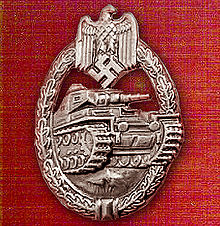Armored force

The armored force is that part of the land forces that is made up exclusively of mechanized units whose main weapon system is the main battle tank . The armored force forms the armored core of many land forces. In Germany , Austria and Switzerland , the armored force is a separate branch .
history

Tank in the First World War
Tanks were already being developed during the First World War , but they were not yet used in closed formations . Therefore, one could not initially speak of a separate arm of the "armored troops". The first use of British tanks took place at Flers during the Battle of the Somme in September 1916. However, as early as 1916 the British Army had its own "Royal Tank Corps". Until the end of the First World War, the German side also used tanks, but comparatively few and largely captured vehicles. In Germany at that time no great value was attached to developing its own tanks; the production figures were marginal compared to the Entente .
Panzer force between 1918 and 1945
Many ideas for the design of a modern armored force came from Major General John Frederick Charles Fuller and Captain Basil Liddell Hart in Great Britain after 1918 .
In France , General Jean Baptiste Estienne , General Aimé Doumenc and Colonel Charles de Gaulle took their bearings from these considerations and developed ideas for tank warfare with mechanized divisions .
In the USA, General Samuel D. Rockenbach (1919 Chief of the US Army Tank Corps) and Colonel George S. Patton were one of the developers of this new combat command .
In the Weimar Republic , Colonel and, since 1931, Major General Oswald Lutz, developed new tactics for the tank weapon from 1924. Heinz Guderian became his chief of staff in 1931. Around 1931, Lutz was the first director of the secret German tank school Kama in Kazan in the Soviet Union , circumventing the Versailles Treaty . Guderian ran this tank school in 1932. In Kazan, during the covert training and armament programs of the Reichswehr, both developed the basics of future tactics and operations for armored weapons. Walther Nehring , too , had been in the operations department of the Troop Office since 1926 with the motorized deployment of troops; In 1932 he became a major general staff officer at Guderian.
In Austria, Colonel and then General Ludwig von Eimannsberger was a pioneer of tank warfare and the use of large armored units from the 1920s to 1930.
In the German Reich , Guderian and his chief of staff Nehring were the main initiators of the further development of the tank weapon. Guderian found that the tank is most effectively used in a closed formation and not sporadically to support foot troops. The structure, equipment and operational principles of the newly established tank divisions were geared towards the main weapon of the battle tank , which made it necessary to generally motorize all parts of these large units . In the course of the rearmament in the German Reich from 1933 onwards , Guderian was able to implement his ideas on the organization and deployment of the armored forces, while in other countries officers with similar ideas were hardly heard. The new foundations contributed to the blitzkrieg successes of the German armed forces at the beginning of the Second World War and are still valid today (see e.g. the approach of the US Army in the Second Gulf War ).
The armored force after 1945
Due to the experiences in World War II, battle tanks were the main weapon and armored units were the main thrust of the land forces during the Cold War . In the armies of NATO and the Warsaw Pact , a far higher number of tanks were held than at present. In 1985 the German Bundeswehr had more than 4,600 main battle tanks, the current number is less than a tenth of them. In the late 1980s, the Soviet Army owned around 29,000 main battle tanks and more than 50 tank divisions. Nevertheless, even after the end of the East-West conflict, the armored troops form the armored core of the land forces in many armies, although a trend towards lighter and more agile troops can be seen at least among NATO troops.
The armored force in the Bundeswehr
The Armored Corps is a branch of service in the army of the Bundeswehr . The German armored troops are part of the army's combat troops and, together with the armored infantry troops, form the armored troop group . The main weapon system of the armored forces is the Leopard 2 main battle tank .
See also
- Armored troop (Bundeswehr)
- Armored troops from the Wehrmacht and Waffen-SS
- Combat of the combined arms
As a historical precursor:
literature
- International Institute for Strategic Studies London (Ed.): Armed Forces 1982/83. In: Military Balance. London, Bernard & Graefe Verlag, Munich 1982.
- Ferdinand von Senger and Etterlin : Tanks of the World. Arms and Amor Press, London 1983.
Individual evidence
- ↑ Groehler p. 51.
- ↑ Neugebauer p. 266.
- ^ Ludwig von Eimannsberger: The war chariot war . JF Lehmann publishing house, Munich 1934.
- ↑ Heinz Guderian: Warning - tanks! The development of the tank weapon, its combat tactics and its operational possibilities . Union Deutsche Verlagsgesellschaft, Stuttgart 1937.
- ↑ Walther Nehring: Armies of Tomorrow. A contribution to the question of military motorization abroad . Voggenreiter Verlag, Potsdam 1935.
- ↑ Armed Forces 1984/85. The "Military Balance" of the International Institute for Strategic Studies, Koblenz 1985, p. 114 ff.
- ↑ Armed Forces 1985/86. The "Military Balance" of the International Institute for Strategic Studies, Koblenz 1986, p. 64 ff.


